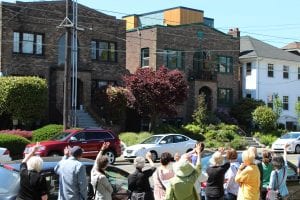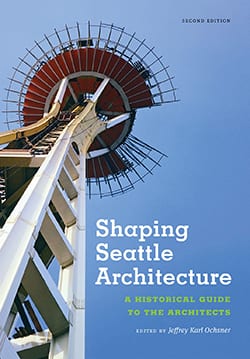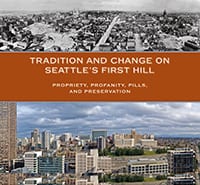Building Dialogue
About the program:
BUILDING DIALOGUE is Historic Seattle’s monthly reading and discussion group. Engage in facilitated conversation about books on preservation and the built environment with others who share an interest — and perhaps some expertise — in the subject.
Our first book is The Death and Life of Great American Cities by Jane Jacobs. We plan to read the book in segments and will hold a virtual (via Zoom) facilitated discussion about each assigned section once a month, for five months. Drop in for one or join us for all – a commitment to participate in every discussion is not required to take part.
| Discussion Date | Discussion Time | Assigned Reading | Scope of Assignment |
| August 19
Click here to view meeting recording |
12-1 PM | Introduction & Part One: The Peculiar Nature of Cities | Chapters 1-6 |
| September 16
Click here to view meeting recording |
12-1 PM | Part Two: The Conditions for City Diversity | Chapters 7-12 |
| October 21
Click here to view meeting recording. |
12-1 PM | Part Three: Forces of Decline and Regeneration | Chapters 13-16 |
| November 18
Click here to view meeting recording. |
12-1 PM | Part Four: Different Tactics | Chapters 17-22 |
About the book:
“A direct and fundamentally optimistic indictment of the short-sightedness and intellectual arrogance that has characterized much of urban planning in [the 20th] century, The Death and Life of Great American Cities has, since its first publication in 1961, become the standard against which all endeavors in that field are measured. In prose of outstanding immediacy, Jane Jacobs writes about what makes streets safe or unsafe; about what constitutes a neighborhood, and what function it serves within the larger organism of the city; about why some neighborhoods remain impoverished while others regenerate themselves. She writes about the salutary role of funeral parlors and tenement windows, the dangers of too much development money and too little diversity. Compassionate, bracingly indignant, and always keenly detailed, Jane Jacobs’s monumental work provides an essential framework for assessing the vitality of all cities.”
About the author:
“Jane Jacobs (1916-2006) was an urbanist and activist whose writings championed a fresh, community-based approach to city building. She had no formal training as a planner, and yet her 1961 treatise, The Death and Life of Great American Cities, introduced ground-breaking ideas about how cities function, evolve and fail. The impact of Jane Jacobs’s observation, activism, and writing has led to a ‘planning blueprint’ for generations of architects, planners, politicians and activists to practice.
Jacobs saw cities as integrated systems that had their own logic and dynamism which would change over time according to how they were used. With an eye for detail, she wrote eloquently about sidewalks, parks, retail design and self-organization. She promoted higher density in cities, short blocks, local economies and mixed uses. Jacobs helped derail the car-centered approach to urban planning in both New York and Toronto, invigorating neighborhood activism by helping stop the expansion of expressways and roads. She lived in Greenwich Village for decades, then moved to Toronto in 1968 where she continued her work and writing on urbanism, economies and social issues until her death in April 2006.
A firm believer in the importance of local residents having input on how their neighborhoods develop, Jacobs encouraged people to familiarize themselves with the places where they live, work, and play.” Learn more here.
Discussion guidelines:
Please self-regulate as you would in an in-person discussion. Remember to be courteous and avoid interrupting when someone is speaking.
If it seems that multiple people want to contribute to the conversation, please raise your hand and we will attempt to call on you in order. Depending on the group size and timing, it may not be possible to get to everyone, every time.
Share the floor: if you have already had a chance to speak, please allow others the chance to contribute to the conversation.
Please avoid side conversations or tangents. The chat feature is a good tool for communicating to a specific person in the group directly or for making a comment to the group without interrupting.
Points of view and opinions will differ. Regardless, participants agree to be respectful and keep the discussion civil so that this can be a space for listening, learning, and exploration. As a safe space for all participants, racism, sexism, homophobic comments, discrimination, insults, etc. will not be tolerated.



